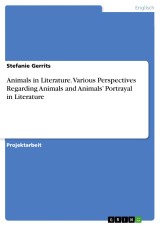Details

Animals in Literature. Various Perspectives Regarding Animals and Animals' Portrayal in Literature
1. Auflage
|
5,99 € |
|
| Verlag: | Grin Verlag |
| Format: | |
| Veröffentl.: | 12.08.2022 |
| ISBN/EAN: | 9783346693969 |
| Sprache: | deutsch |
| Anzahl Seiten: | 9 |
Dieses eBook enthält ein Wasserzeichen.
Beschreibungen
Projektarbeit aus dem Jahr 2020 im Fachbereich Anglistik - Literatur, Note: 1,3, Universität Trier (Universität), Veranstaltung: Animals in Literature, Sprache: Deutsch, Abstract: Animals in Literature was a course about various perspectives regarding animals and animals’ portrayal in literature. Multiple topics were being discussed such as anthropomorphism, animals as food, animal voices or animals in correlation to sexism and racism. Our primary texts were "Heart of Darkness" by Joseph Conrad and "Animal Farm" by George Orwell. These texts were the foundation for different discussions. Those rose my awareness for the importance
animals have in literature, however, this course additionally showed how rarely readers pay attention to it.
In "Heart of Darkness", we analyzed how animals are being used to represent racist thoughts, for instance, while using adjectives that usually describe animal behavior, to characterize actions and sounds of dark-skinned people. Some examples applied in "Heart of Darkness" are 'crawling', 'on all fours' or 'creeping'. Another discussion displayed how people or classes are being suppressed or highly regarded using words connotated to different values of diverse animals.
"Animal Farm", on the other hand, is an accurate representation of human behavior. Especially, character traits that are often considered to be animalistic behavior proved to be human behavior as well. One debatable theme was whether authors are able to express animal’s thoughts and feelings due to the reason that they can only make assumptions influenced by behavior they know from animals surrounding them. Furthermore, we examined various historical aspects, for example how animals were regarded and treated as food over time and how people’s behavior to their value
changed.
A theme which occurred in both Novellas was how certain species symbolize social classes. Some species, such as lions or wolves, represent higher class as a result of aesthetic, power and strength, and intelligence. To the contrary, farm animals such as chicken, donkeys, cows, or pig, are portrayed as lower class because they are generally regarded as dirty and unaesthetic. Their objectification as being products and barely being regarded as living and feeling creatures have been transferred into literature as well, representing farm animals as a prototypical class without influence, danger or intelligence.
animals have in literature, however, this course additionally showed how rarely readers pay attention to it.
In "Heart of Darkness", we analyzed how animals are being used to represent racist thoughts, for instance, while using adjectives that usually describe animal behavior, to characterize actions and sounds of dark-skinned people. Some examples applied in "Heart of Darkness" are 'crawling', 'on all fours' or 'creeping'. Another discussion displayed how people or classes are being suppressed or highly regarded using words connotated to different values of diverse animals.
"Animal Farm", on the other hand, is an accurate representation of human behavior. Especially, character traits that are often considered to be animalistic behavior proved to be human behavior as well. One debatable theme was whether authors are able to express animal’s thoughts and feelings due to the reason that they can only make assumptions influenced by behavior they know from animals surrounding them. Furthermore, we examined various historical aspects, for example how animals were regarded and treated as food over time and how people’s behavior to their value
changed.
A theme which occurred in both Novellas was how certain species symbolize social classes. Some species, such as lions or wolves, represent higher class as a result of aesthetic, power and strength, and intelligence. To the contrary, farm animals such as chicken, donkeys, cows, or pig, are portrayed as lower class because they are generally regarded as dirty and unaesthetic. Their objectification as being products and barely being regarded as living and feeling creatures have been transferred into literature as well, representing farm animals as a prototypical class without influence, danger or intelligence.

















